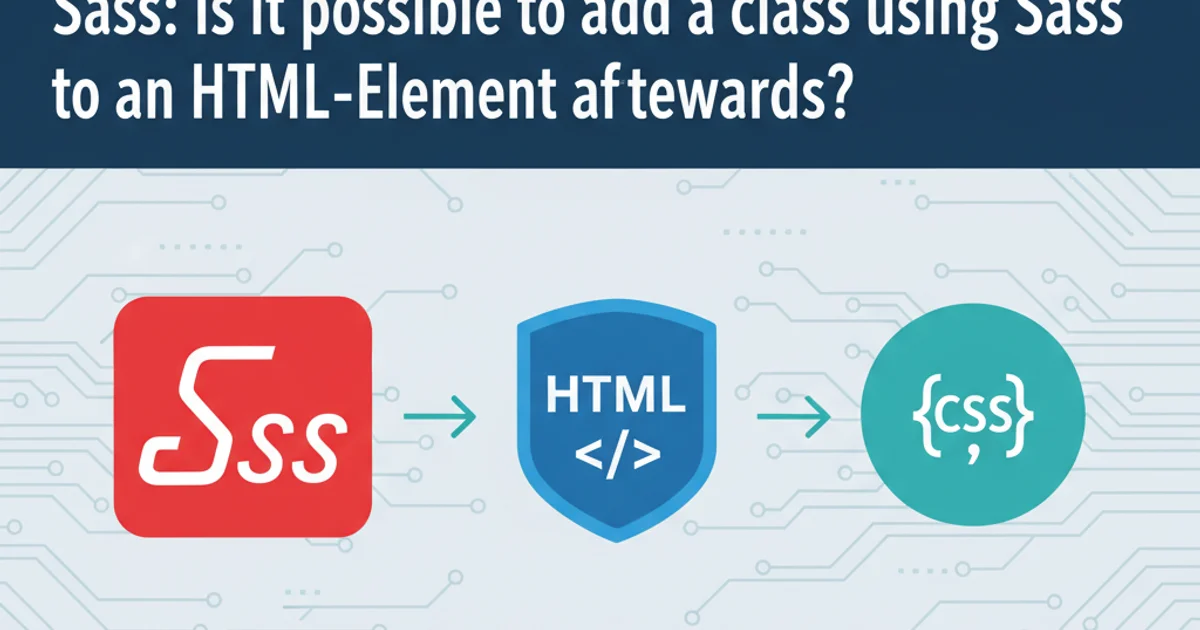Sass: Is it possible to add a class using Sass to an HTML-Element afterwards?
Categories:
Sass: Dynamic Class Addition to HTML Elements - A Deep Dive

Explore the capabilities and limitations of Sass for dynamically adding classes to HTML elements, understanding its role as a preprocessor.
Sass (Syntactically Awesome Style Sheets) is a powerful CSS preprocessor that extends the capabilities of standard CSS. Developers often wonder if Sass can directly manipulate the DOM, such as adding classes to HTML elements after the page has loaded. This article clarifies Sass's role, its limitations in direct DOM manipulation, and how to achieve dynamic styling effects using Sass in conjunction with HTML and JavaScript.
Understanding Sass's Role: Preprocessing vs. Runtime
Sass operates purely at the preprocessing stage. This means that all Sass code is compiled into standard CSS before the browser ever sees it. Its primary function is to make CSS more maintainable, reusable, and dynamic during development, not to interact with the live HTML document in the browser. Therefore, Sass itself cannot "add a class to an HTML element afterwards" in the same way JavaScript can.
flowchart TD
A[Sass Code] --> B{Sass Compiler}
B --> C[Compiled CSS File]
C --> D[Browser Loads HTML & CSS]
D --> E[Browser Renders Page]
E --x F[Sass Directly Modifies DOM]
F["Sass Directly Modifies DOM"]:::disabled
classDef disabled fill:#f9f,stroke:#333,stroke-width:2px,color:#888;
style F fill:#f9f,stroke:#333,stroke-width:2px,color:#888Sass Compilation and Browser Rendering Flow
The diagram above illustrates that Sass's influence ends once it's compiled into CSS. The browser then interprets this static CSS file. Any dynamic changes to the HTML structure or element classes must be handled by client-side scripting languages like JavaScript.
Achieving Dynamic Styling with Sass and JavaScript
While Sass cannot directly add classes at runtime, it plays a crucial role in defining the styles that will be applied when a class is added by JavaScript. The typical workflow involves:
- Sass: Define styles for various states or components, including styles for classes that will be dynamically added.
- HTML: Structure your content.
- JavaScript: Add or remove classes from HTML elements based on user interaction, application state, or other conditions.
// _components.scss
.button {
padding: 10px 20px;
border: 1px solid #ccc;
background-color: #f0f0f0;
color: #333;
transition: all 0.3s ease;
&.active {
background-color: #007bff;
color: #fff;
border-color: #007bff;
box-shadow: 0 2px 5px rgba(0, 123, 255, 0.3);
}
&.disabled {
opacity: 0.6;
cursor: not-allowed;
background-color: #e9ecef;
color: #6c757d;
}
}
// main.scss
@import 'components';
// Other global styles...
<button id="myButton" class="button">Click Me</button>
<button id="anotherButton" class="button disabled">Disabled Button</button>
// script.js
document.addEventListener('DOMContentLoaded', () => {
const myButton = document.getElementById('myButton');
const anotherButton = document.getElementById('anotherButton');
myButton.addEventListener('click', () => {
// Toggle the 'active' class on click
myButton.classList.toggle('active');
console.log('Button active state:', myButton.classList.contains('active'));
});
// Example of adding a class programmatically after some condition
setTimeout(() => {
if (!anotherButton.classList.contains('active')) {
anotherButton.classList.add('active');
console.log('Another button is now active!');
}
}, 3000);
});
d-none, text-center, bg-primary) are pre-defined in their Sass source. You can leverage these classes directly with JavaScript without writing custom Sass, or extend them using Sass's @extend or mixins.Advanced Sass Techniques for Dynamic Styling
While Sass doesn't directly manipulate the DOM, it can generate highly flexible and maintainable CSS that supports dynamic changes. Techniques like using loops, maps, and mixins can create a robust styling system.
For instance, you can generate a series of utility classes that JavaScript can then apply. This is a common pattern in design systems.
// _utilities.scss
$spacers: (
0: 0,
1: 0.25rem,
2: 0.5rem,
3: 1rem,
4: 1.5rem,
5: 3rem
);
@each $size, $length in $spacers {
.m-#{$size} {
margin: $length !important;
}
.p-#{$size} {
padding: $length !important;
}
.mt-#{$size} {
margin-top: $length !important;
}
// ... and so on for other directions
}
// This Sass generates classes like .m-1, .p-3, .mt-5, etc.
// which can then be added to HTML elements via JavaScript.
This Sass snippet generates a set of margin and padding utility classes. JavaScript can then add .m-3 to an element to apply a margin: 1rem !important; style, effectively achieving dynamic spacing without writing inline styles or complex JavaScript for each case.